Themed collection d0 organometallics in catalysis

Front cover

Inside front cover

Back cover
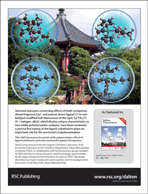
Contents list
d0 organometallics in catalysis
Welcome to this themed issue of Dalton Transactions entitled “d0 organometallics in catalysis”.

Dalton Trans., 2011,40, 7665-7665
https://doi.org/10.1039/C1DT90099D
Half-titanocenes for precise olefin polymerisation : effects of ligand substituents and some mechanistic aspects
Selected examples concerning effects of both cyclopentadienyl fragment (Cp′) and anionic donor ligand (Y) in nonbridged modified half-titanocenes of the type, Cp′TiX2(Y) (X = halogen, alkyl), as new type of olefin polymerisation catalysts have been reviewed.

Dalton Trans., 2011,40, 7666-7682
https://doi.org/10.1039/C1DT10086F
Structure–activity relationships in group 3 metal catalysts for asymmetric intramolecular alkene hydroamination . An investigation of ligands based on the axially chiral 1,1′-binaphthyl-2,2′-diamine motif
From a series of N,N′-disubstituted-1,1′-binaphthyl-2,2′-diamines, several group 3 metal complexes were synthesized and applied to catalysis of intramolecular alkene hydroamination.

Dalton Trans., 2011,40, 7697-7700
https://doi.org/10.1039/C1DT10222B
Modular ligand variation in calcium bisimidazoline complexes: effects on ligand redistribution and hydroamination catalysis
Variation of the N-substituent of chiral imidazoline ligands has a profound effect on the ligand redistribution in calcium complexes; the effect on catalytic hydroamination/cyclisation has been probed.
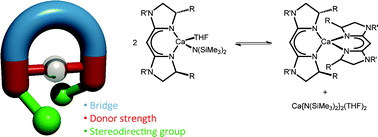
Dalton Trans., 2011,40, 7693-7696
https://doi.org/10.1039/C1DT10732A
Catalytic
dehydrogenation of dimethylamine borane by group 4 metallocene alkyne complexes and homoleptic amido compounds
The catalytic dehydrogenation of dimethylamine borane using well-defined group 4 metallocene alkyne complexes and homoleptic group 4 amido complexes is presented.
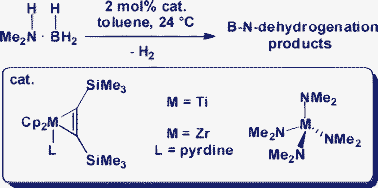
Dalton Trans., 2011,40, 7689-7692
https://doi.org/10.1039/C1DT10366K
Mononuclear titanium compounds based on the silyl -linked bis(amidinate) ligand : synthesis, characterization and ethylene polymerization
The mononuclear titanium compounds supported with a silyl-linked bis(amidinate) ligand were prepared, and showed good activity towards ethylene polymerization after activation with MAO.

Dalton Trans., 2011,40, 7686-7688
https://doi.org/10.1039/C1DT10365B
Differences in the stability of zirconium(IV) complexes related to catalytic phosphine dehydrocoupling reactions
Relating to the catalytic dehydrocoupling of secondary phosphine substrates, zirconium phosphide complexes supported by triamidoamine and pentamethylcyclopentadienyl ligands exhibit different stability that is attributed to β-hydride elimination.

Dalton Trans., 2011,40, 7683-7685
https://doi.org/10.1039/C1DT10105F
Insertion and reduction chemistry of isocyanide with a cyclometalated ditantalum hydride complex
Reactions of tert-butylisocyanide with a cyclometalated ditantalum hydride were investigated.

Dalton Trans., 2011,40, 7701-7703
https://doi.org/10.1039/C1DT10040H
Intermolecular hydroamination of oxygen-substituted allenes . New routes for the synthesis of N,O-chelated zirconium and titanium amido complexes
The intermolecular hydroamination of oxygen-substituted allenes serves as a route toward amine proligands which in turn can be used for the synthesis of N,O-chelating complexes of zirconium and titanium. The new complexes are also effective aminoalkene cyclohydroamination precatalysts.

Dalton Trans., 2011,40, 7769-7776
https://doi.org/10.1039/C1DT10448A
Structural characterization of TaMe3Cl2 and Ta(PMe3)2Me3Cl2 , a pair of five and seven-coordinate d0 tantalum methyl compounds
The molecular structures of both TaMe3Cl2 and Ta(PMe3)2Me3Cl2 have been determined by X-ray diffraction thereby demonstrating that, in the solid state, these complexes respectively adopt trigonal bipyramidal and capped trigonal prismatic geometries.

Dalton Trans., 2011,40, 7777-7782
https://doi.org/10.1039/C1DT10806A
Synthesis and hydroamination catalysis with 3-aryl substituted pyrrolyl and dipyrrolylmethane titanium(IV) complexes
Titanium hydroamination rates are enhanced by the addition of electron-withdrawing aryl groups in the 3-position of a dipyrrolylmethane ancillary ligand.
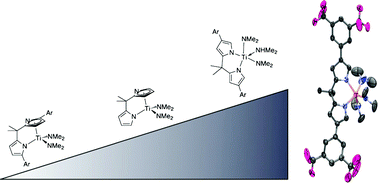
Dalton Trans., 2011,40, 7762-7768
https://doi.org/10.1039/C1DT10127G
DFT characterization of key intermediates in thiols oxidation catalyzed by amavadin
Key intermediates of thiol oxidation catalyzed by amavadin have been investigated by means of DFT and QTAIM methods.
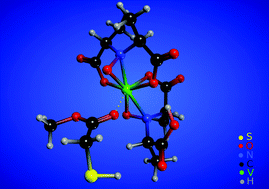
Dalton Trans., 2011,40, 7704-7712
https://doi.org/10.1039/C1DT10103J
Anhydrous mono- and dinuclear tris(quinolinolate) complexes of scandium: the missing structures of rare earth metal 8-quinolinolates
The first monomeric anhydrous scandium tris(8-quinolinolate) complex has been synthesized and characterized by X-ray analysis and DFT calculations.

Dalton Trans., 2011,40, 7713-7717
https://doi.org/10.1039/C1DT10318K
Cyclisation of α,ω-dienes promoted by bis(indenyl)zirconium sandwich and ansa-titanocene dinitrogen complexes
Bis(indenyl)zirconium and ansa-titanium dinitrogen complexes were explored as isolable reduced metallocene species for the cyclisation of α,ω-dienes.

Dalton Trans., 2011,40, 7737-7747
https://doi.org/10.1039/C1DT10149H
Synthesis and reactivity of cationic niobium and tantalum methyl complexes supported by imido and β-diketiminato ligands
Four-coordinate, cationic, M–Me (M = Nb, Ta) complexes were synthesized and tested for their reactivity toward unsaturated and protic small-molecule substrates.

Dalton Trans., 2011,40, 7718-7729
https://doi.org/10.1039/C1DT10202H
Scandium alkyl and amide complexes containing a cyclen-derived (NNNN) macrocyclic ligand: synthesis, structure and ring-opening polymerization activity toward lactide monomers
Scandium amide complexes containing a cyclen-derived (NNNN) macrocyclic ligand initiated the ring-opening polymerization of meso-lactide.

Dalton Trans., 2011,40, 7748-7754
https://doi.org/10.1039/C1DT10075K
Stoichiometric reactivity of dialkylamine boranes with alkaline earth silylamides
Heteroleptic and homoleptic group 2 silylamides catalyse the dehydrocoupling of dialkylamine boranes, R2NH·BH3, via an apparent elimination/insertion mechanism. Key intermediates containing [R2NBH2R2NBH3]− anions are formed by M–N insertion of olefin-isoelectronic R2NBH2 species.

Dalton Trans., 2011,40, 7783-7790
https://doi.org/10.1039/C1DT10171D
Highly trans-1,4 selective (co-)polymerization of butadiene and isoprene with quinolyl anilido rare earth metal bis(alkyl) precursors
Rare earth alkyl complexes activated by aluminium alkyls and organoborates exhibited high trans-1,4 selectivity for butadiene and isoprene homo- and co-polymerizations.

Dalton Trans., 2011,40, 7755-7761
https://doi.org/10.1039/C1DT10100E
Syntheses, reactions, and ethylene polymerization of titanium complexes with [N,N,S] ligands
Five and four-coordinate titanium complexes with tridentate dianionic arylsulfide ligands have been synthesized, characterized and applied for ethylene polymerization.
![Graphical abstract: Syntheses, reactions, and ethylene polymerization of titanium complexes with [N,N,S] ligands](/en/Image/Get?imageInfo.ImageType=GA&imageInfo.ImageIdentifier.ManuscriptID=C0DT01800G&imageInfo.ImageIdentifier.Year=2011)
Dalton Trans., 2011,40, 7730-7736
https://doi.org/10.1039/C0DT01800G
Titanium “constrained geometry” complexes with pendant arene groups
Arene substituted constrained geometry catalyst precursors are prepared, characterized and an examination of their activities for the polymerization and copolymerization of styrene and ethylene are reported.
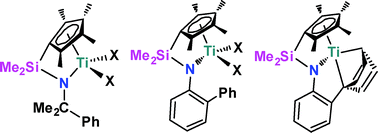
Dalton Trans., 2011,40, 2861-2867
https://doi.org/10.1039/C0DT01530J
About this collection
d0 organometallics in catalysis